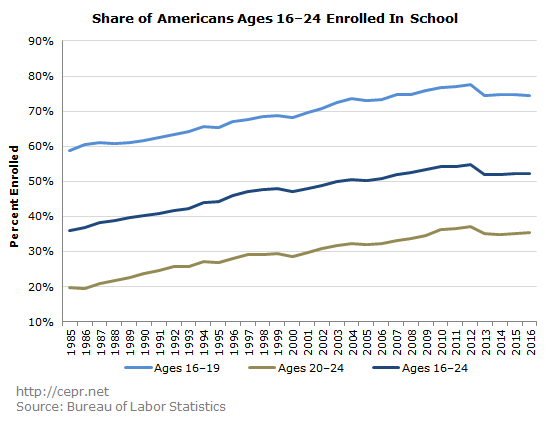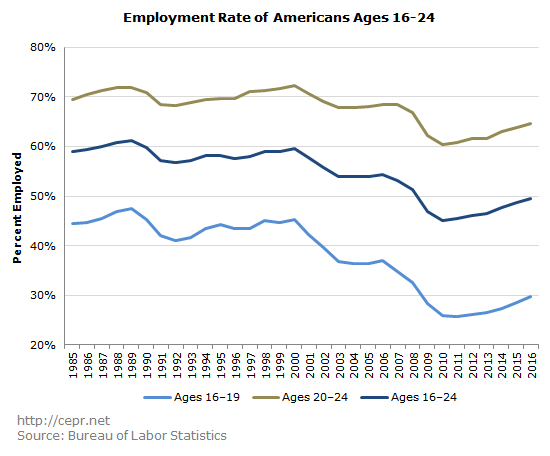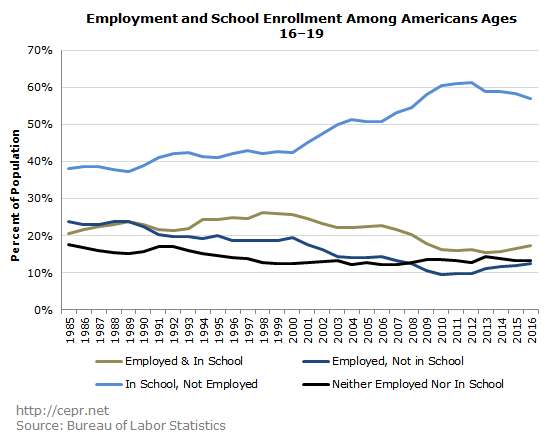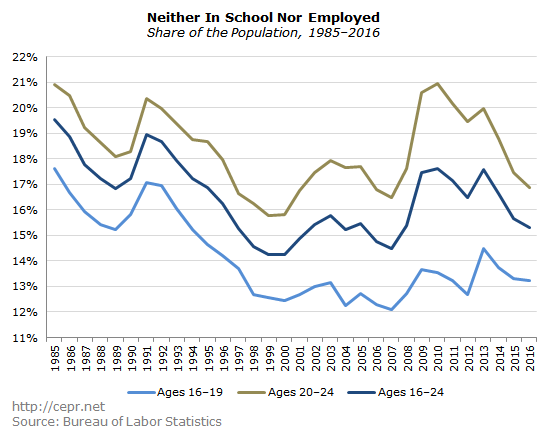March 14, 2017
Over the past three decades, there have been two major changes in how young people spend their time. First, rates of both high school and college enrollment have gone up, leading to an increase in the share of 16–24 year-olds enrolled in formal schooling:

Second, employment rates have fallen, especially for 16–19 year-olds:

Both school enrollment and employment are productive ways for young people to spend their time. Along with lending meaning to young peoples’ lives in the short-term, these activities boost their future employment prospects, often leading to higher earnings and lower rates of unemployment down the road.
During the two decades preceding the 2008–2009 recession, the share of young people neither employed nor enrolled in school had generally been falling. As of 1985, 17.6 percent of 16–19 year-olds were neither workers nor students; by 2007, this share had reached an all-time low of 12.1 percent. However, employment fell dramatically among 16–19 year-olds during the recession, causing the share of 16–19 year-olds not employed and not in school to rise all the way to 14.5 percent by 2013. Thanks to improvements in the labor market, this measure had improved to 13.2 percent as of 2016, though this is still a higher rate than from before the recession.
The figure below shows the trends in employment and school enrollment among 16-19 year-olds from 1985 to 2016. During this time, there were moderate declines in the shares of 16–19 year-olds who were “Employed and In School” and “Neither Employed Nor In School”. However, the biggest shift is in terms of 16–19 year-olds pursuing one activity over the other. As of 2016, 12.4 percent of 16–19 year-olds were employed but not in school, down from 23.7 percent in 1985; by contrast, the share enrolled in school but not employed was 57.1 percent, up from 38.0 percent three decades earlier.

For 20–24 year-olds, the trends are similar in some ways but different in others. The most obvious similarity is the harm caused by the weak economy. Between 1985 and 2000, the share of 20–24 year-olds not in school and not working was on the decline, falling from 20.9 percent in 1985 to 15.8 percent in 1999 and 2000. The 2001 recession pushed this rate up to nearly 18 percent; it thereafter declined to 16.5 percent by 2007. However, the rate shot up to 20.9 percent by 2010, essentially erasing 22 years of progress in just three years. The rate is now back down to 16.9 percent, slightly higher than it was before the Great Recession.
As with 16–19 year-olds, among 20–24 year-olds, the share who are employed but not in school has fallen more than 10 percentage-points since 1985. (It went from 59.5 percent in 1985 to 47.7 percent last year.) The share of 20–24 year-olds in school but not employed nearly doubled between 1985 and 2016, rising from 9.5 to 18.5 percent of the population. However, in contrast to the trend for 16–19 year-olds, the share of 20–24 year-olds who are both employed and in school has risen, going from 10.1 percent in 1985 to 16.9 percent in 2016. These trends are depicted in the figure below.

Finally, it is worth zeroing in on the share of the broader 16–24 population that is neither employed nor in school. As stated earlier, in 1985, 17.6 percent of 16-19 year-olds and 20.9 percent of 20–24 year-olds were neither working nor in school; for the overall 16–24 population, it was 19.5 percent. This rate has generally been declining over time, but it spiked during each of the three recessions occurring between 1985 and 2016. This shows that, during economic downturns, the rise in school enrollment among young people does not make up for the decline in employment opportunities. As of 1999 and 2000, just 14.3 percent of 16–24 year-olds were out of a job and out of school; this rate spiked to 15.8 percent by 2003, though it fell back to 14.5 percent by 2007. After 2007, there was yet another increase in 16–24 year-olds neither employed nor in school, with the rate peaking at 17.6 percent. By 2016, it was down to 15.3 percent — lower than it was in 1985, but also higher than it was in the early and mid-2000s. So while most economic analyses focus on the recession’s impact on prime-age workers, it’s clear that young Americans would greatly benefit from a stronger economy as well.
The figure below shows the share of 16–24 year-olds who are neither employed nor in school for each year from 1985 to 2016.







